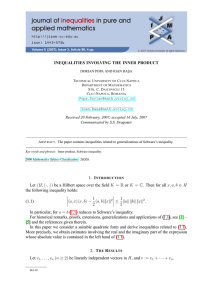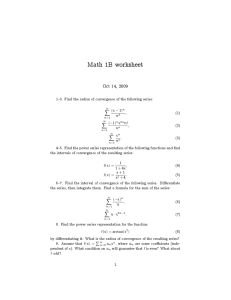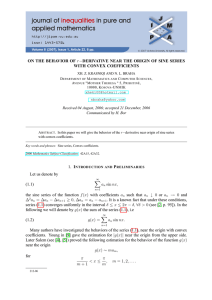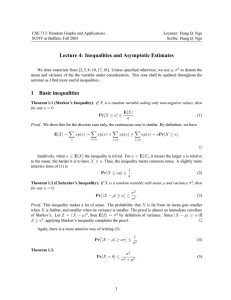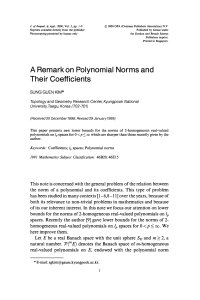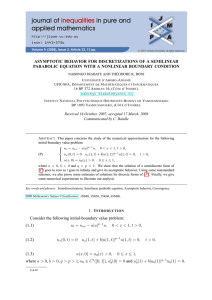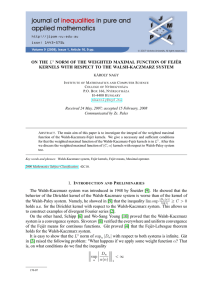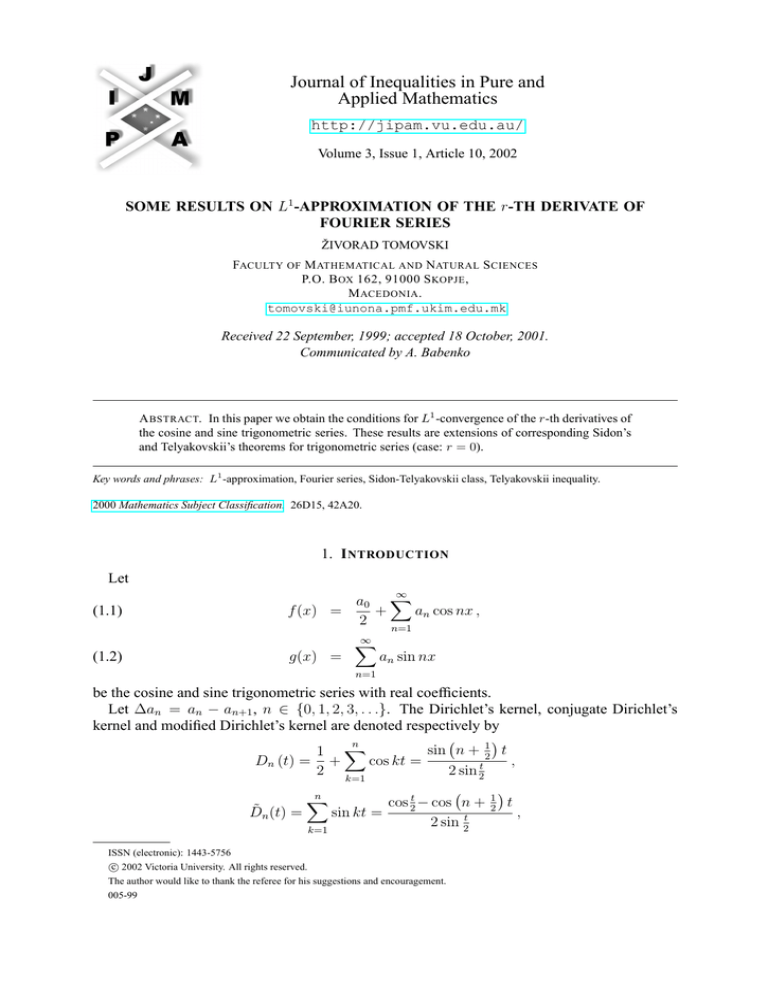
Journal of Inequalities in Pure and
Applied Mathematics
http://jipam.vu.edu.au/
Volume 3, Issue 1, Article 10, 2002
SOME RESULTS ON L1 -APPROXIMATION OF THE r-TH DERIVATE OF
FOURIER SERIES
ŽIVORAD TOMOVSKI
FACULTY OF M ATHEMATICAL AND NATURAL S CIENCES
P.O. B OX 162, 91000 S KOPJE ,
M ACEDONIA .
tomovski@iunona.pmf.ukim.edu.mk
Received 22 September, 1999; accepted 18 October, 2001.
Communicated by A. Babenko
A BSTRACT. In this paper we obtain the conditions for L1 -convergence of the r-th derivatives of
the cosine and sine trigonometric series. These results are extensions of corresponding Sidon’s
and Telyakovskii’s theorems for trigonometric series (case: r = 0).
Key words and phrases: L1 -approximation, Fourier series, Sidon-Telyakovskii class, Telyakovskii inequality.
2000 Mathematics Subject Classification. 26D15, 42A20.
1. I NTRODUCTION
Let
∞
(1.1)
a0 X
f (x) =
+
an cos nx ,
2
n=1
(1.2)
g(x) =
∞
X
an sin nx
n=1
be the cosine and sine trigonometric series with real coefficients.
Let ∆an = an − an+1 , n ∈ {0, 1, 2, 3, . . .}. The Dirichlet’s kernel, conjugate Dirichlet’s
kernel and modified Dirichlet’s kernel are denoted respectively by
n
sin n + 12 t
1 X
Dn (t) = +
cos kt =
,
2 k=1
2 sin 2t
n
X
cos 2t − cos n + 12 t
D̃n (t) =
sin kt =
,
t
2
sin
2
k=1
ISSN (electronic): 1443-5756
c 2002 Victoria University. All rights reserved.
The author would like to thank the referee for his suggestions and encouragement.
005-99
2
Ž IVORAD T OMOVSKI
cos n + 12 t
1
t
Dn (t) = − ctg + D̃n (t) = −
.
2
2
2 sin 2t
Let
n
n
1 X −ikt
1 X ikt
En (t) = +
e and E−n (t) = +
e .
2 k=1
2 k=1
(r)
(r)
Then the r-th derivatives Dn (t) and D̃n (t) can be written as
(r)
(1.3)
2Dn(r) (t) = En(r) (t) + E−n (t) ,
(1.4)
2iD̃n(r) (t) = En(r) (t) − E−n (t) .
(r)
In [2], Sidon proved the following theorem.
∞
Theorem
1.1. Let {αn }∞
n=1 and {pn }n=1 be sequences such that |αn | ≤ 1, for every n and let
P∞
n=1 |pn | converge. If
(1.5)
an =
∞
k
X
pk X
k=n
k
αl , n ∈ N
l=n
then the cosine series (1.1) is the Fourier series of its sum f.
Several authors have studied the problem of L1 −convergence of the series (1.1) and (1.2).
In [4] Telyakovskii defined the following class of L1 -convergence of Fourier series. A sequence {ak }∞
ak → 0 as k → ∞ and there exists a
k=0 belongs to the class S, or {ak } ∈ S ifP
∞
monotonically decreasing sequence {Ak }k=0 such that ∞
k=0 Ak < ∞ and |∆ak | ≤ Ak for all
k.
The importance of Telyakovskii’s contributions are twofold. Firstly, he expressed Sidon’s
conditions (1.5) in a succinct equivalent form, and secondly, he showed that the class S is also
a class of L1 -convergence. Thus, the class S is usually called the Sidon–Telyakovskii class.
In the same paper, Telyakovskii proved the following two theorems.
Theorem 1.2. [4]. Let the coefficients of the series f (x) belong to the class S. Then the series
is a Fourier series and the following inequality holds:
Z π
∞
X
|f (x)| dx ≤ M
An ,
0
n=0
where M is a positive constant, independent on f .
Theorem 1.3. [4]. Let the coefficients of the series g (x) belong to the class S. Then the
following inequality holds for p = 1, 2, 3, . . .
!
Z π
p
∞
X
X
|an |
|g (x)| dx =
+O
An .
n
π/(p+1)
n=1
n=1
P
|an |
In particular, g (x) is a Fourier series iff ∞
n=1 n < ∞.
In [5], we extended the Sidon–Telyakovskii class S = S0 , i.e., we defined the class Sr ,
r = 1, 2, 3, . . . as follows: {ak }∞
if ak → 0 as k → ∞ and there exists a monotonically
k=1 ∈ SrP
∞
r
decreasing sequence {Ak }k=1 P
such that ∞
k=1 k Ak < ∞ and |∆ak | ≤ Ak for all k.
∞
r
We note that by Ak ↓ 0 and k=1 k Ak < ∞, we get
(1.6)
k r+1 Ak = o (1) ,
k → ∞.
It is trivially to see that Sr+1 ⊂ Sr for all r = 1, 2, 3, .... Now, let {an }∞
n=1 ∈ S1 . For
∞
arbitrary real number a0 , we shall prove that sequence {an }n=0 belongs to S0 . We define A0 =
J. Inequal. Pure and Appl. Math., 3(1) Art. 10, 2002
http://jipam.vu.edu.au/
S OME R ESULTS ON L1 -A PPROXIMATION
OF THE
r- TH D ERIVATE OF F OURIER S ERIES
3
max(|∆a0 |, A1 ). Then |∆a0 | ≤ A0 , i.e. |∆an | ≤ An , for all n ∈ {0, 1, 2, ...} and {An }∞
n=0 is
monotonically decreasing sequence.
On the other hand,
∞
∞
X
X
A n ≤ A0 +
nAn < ∞ .
n=0
{an }∞
n=0
Thus,
implication
n=1
∈ S0 , i.e. Sr+1 ⊂ Sr , for all r = 0, 1, 2, . . .. The next example verifies that the
{an } ∈ Sr+1 ⇒ {an } ∈ Sr ,
r = 0, 1, 2, . . .
is not reversible.
P
1
Example 1.1. For n = 0, 1, 2, 3, ... define an = ∞
k=n+1 k2 . Then an → 0 as n → ∞ and for
1
∞
n = 0, 1, 2, 3, . . ., ∆an = (n+1)
/ S1 .
2 . Firstly we shall show that {an }n=1 ∈
∞
Let {AnP
}n=1 is an arbitrary
sequence such that A ↓ 0 and ∆an = |∆an | ≤ An .
P∞ positive
n
However, ∞
nA
≥
is
divergent,
i.e. {an } ∈
/ S1 .
n
n=1
n=1 (n+1)2
P
1
Now, for all n = 0, 1, 2, . . . let An = (n+1)2 . Then An ↓ 0, |∆an | ≤ An and ∞
n=0 An =
P∞ 1
∞
n=1 n2 < ∞, i.e. {an }n=0 ∈ S0 .
∞
Our next example will show that there exists a sequence {an }∞
n=1 such that {an }n=1 ∈ Sr but
{an }∞
/ Sr+1 , for all r = 1, 2, 3, . . ..
n=1 ∈
P∞ 1
Namely, for all n = 1, 2, 3, . . . let an =
k=n kr+2 . Then an → 0 as n → ∞ and for
1
n = 1, 2, 3, . . . , ∆an = nr+2
. Let {An }∞
is
an
arbitrary positive sequence such that An ↓ 0
n=1
and ∆an = |∆an | ≤ An . However,
∞
X
n
r+1
An ≥
n=1
∞
X
n
1
r+1
n=1
nr+2
∞
X
1
=
n
n=1
is divergent, i.e. {an } ∈
/ Sr+1 . On the other hand, for all n = 1, 2, . . . let An =
P
P∞ 1
r
An ↓ 0, |∆an | ≤ An and ∞
n=1 n An =
n=1 n2 < ∞, i.e. {an } ∈ Sr .
In the same paper [5] we proved the following theorem.
1
.
nr+2
Then
Theorem 1.4. [5]. Let the coefficients of the series (1.1) belong to the class Sr , r = 0, 1, 2, ....
Then the r−th derivative of the series (1.1) is a Fourier series of some f (r) ∈ L1 (0, π) and the
following inequality holds:
Z π
∞
X
(r)
f (x) dx ≤ M
n r An ,
0
n=1
where 0 < M = M (r) < ∞.
This is an extension of the Telyakovskii Theorem 1.2.
2. R ESULTS
In this paper, we shall prove the following main results.
Theorem 2.1. A null sequence {an } belongs to the class Sr , r = 0, 1, 2, . . . if and only if it can
be represented as
(2.1)
an =
∞
k
X
pk X
k=n
J. Inequal. Pure and Appl. Math., 3(1) Art. 10, 2002
k
αl , n ∈ N
l=n
http://jipam.vu.edu.au/
4
Ž IVORAD T OMOVSKI
∞
where {αn }∞
n=1 and {pn }n=1 are sequences such that |αn | ≤ 1, for all n and
∞
X
nr |pn | < ∞.
n=1
∞
∞
Corollary
P∞ r 2.2. Let {αn }n=1 and {pn }n=1 be sequences such that |αn | ≤ 1, for every n and let
n=1 n |pn | < ∞, r = 0, 1, 2, . . . . If
an =
k
∞
X
pk X
k=n
k
αl , n ∈ N
l=n
then the r−th derivate of the series (1.1) is a Fourier series of some f (r) ∈ L1 .
Theorem 2.3. Let the coefficients of the series g (x) belong to the class Sr , r = 0, 1, 2, . . .
Then the r-th derivate of the series (1.2) converges to a function and for m = 1, 2, 3, . . . the
following inequality holds:
!
Z π
m
∞
X
X
(r)
g (x) dx ≤ M
(∗)
|an | · nr−1 +
n r An ,
π/(m+1)
n=1
n=1
where
0 < M = M (r) < ∞ .
P∞
Moreover, if n=1 nr−1 |an | < ∞, then the r-th derivate of the series (1.2) is a Fourier series of
some g (r) ∈ L1 (0, π) and
!
Z π
∞
∞
X
X
(r)
g (x) dx ≤ M
|an | · nr−1 +
n r An
0
n=1
n=1
Corollary 2.4. Let the coefficients of the series g (x) belong to the class Sr , r ≥ 1. Then the
following inequality holds:
Z π
∞
X
(r)
g (x) dx ≤ M
n r An ,
0
n=1
where 0 < M = M (r) < ∞.
3. L EMMAS
For the proof of our new theorems we need the following lemmas.
The following lemma proved by Sheng, can be reformulated in the following way.
Lemma 3.1. [1] Let r be a nonnegative integer and x ∈ (0, π], where n ≥ 1. Then
r
1
kπ
1 k
X
n
+
sin
n
+
x
+
2
2
2
Dn(r) (x) =
ϕk (x),
r+1−k
x
sin 2
k=0
where ϕr ≡ 12 and ϕk , k = 0, 1, 2, . . . , r − 1 denotes various entire 4π – periodic functions of
x, independent of n. More precisely, ϕk , k = 0, 1, 2, . . . , r are trigonometric polynomials of x2 .
J. Inequal. Pure and Appl. Math., 3(1) Art. 10, 2002
http://jipam.vu.edu.au/
S OME R ESULTS ON L1 -A PPROXIMATION
OF THE
r- TH D ERIVATE OF F OURIER S ERIES
5
Lemma 3.2. Let {αj }kj=0 be a sequence of real numbers. Then the following relation holds for
ν = 0, 1, 2, . . . , r and r = 0, 1, 2, . . .
Z π
k
X
1
ν+3
1 ν
sin
j
+
x
+
π
j
+
2
2
2
Uk =
αj
dx
r+1−ν
x
π/(k+1) j=0
sin 2
!1/2
k
X
1
.
αj2 (j + 1)2ν
= O (k + 1)r−ν+ 2
j=0
Proof. Applying first Cauchy–Buniakowski inequality, yields
"Z
π
dx
2(r+1−ν)
x
Uk ≤
π/(k+1)
#1/2
sin 2
#2 1/2
" k
ν
Z π
X
1
(ν + 3)π
1
×
αj j +
sin j +
x+
dx
.
π/(k+1)
2
2
2
j=0
Since
Z
π
π/(k+1)
sin
dx
≤ π 2(r+1−ν)
2(r+1−ν)
x
2
≤
Z
π
dx
π/(k+1)
x2(r+1−ν)
π(k + 1)2(r+1−ν)−1
2(r + 1 − ν) − 1
≤ π(k + 1)2(r+1−ν)−1 ,
we have
1/2
π(k + 1)2(r+1−ν)−1
" k
ν
#2 1/2
Z π X
1
1
ν+3
×
αj j +
sin j +
x+
π
dx
0
2
2
2
j=0
ν
#2 1/2
Z 2π "X
k
1/2
1
ν+3
≤ 2π(k + 1)2(r+1−ν)−1
αj j +
sin (2j + 1)t +
π
dt
.
0
2
2
j=0
Uk ≤
Then, applying Parseval’s equality, we obtain:
h
Uk ≤ 2π (k + 1)
" k
i1/2 X
2(r+1−ν)−1
#1/2
|αj |2 (j + 1)2ν
.
j=0
Finally,
1
Uk = O (k + 1)r−ν+ 2
k
X
!1/2
αj2 (j + 1)2ν
.
j=0
J. Inequal. Pure and Appl. Math., 3(1) Art. 10, 2002
http://jipam.vu.edu.au/
6
Ž IVORAD T OMOVSKI
Lemma 3.3. Let r ∈ {0, 1, 2, 3, . . . } and {αk }nk=0 be a sequence of real numbers such that
|αk | ≤ 1, for all k. Then there exists a finite constant M = M (r) > 0 such that for any n ≥ 0
Z π
n
X
(r)
(∗∗)
αk Dk (x) dx ≤ M · (n + 1)r+1 .
π/(n+1)
k=0
Proof. Similar to Lemma 3.1 it is not difficult to proof the following equality
r
X
n + 12 k sin n + 12 x + k+3
π
(r)
2
Dn (x) =
ϕk (x),
r+1−k
x
sin
k=0
2
where ϕk denotes the same various 4π-periodic functions of x, independent of n.
Now, we have:
n
Z π
X
(r)
αk Dk (x) dx
π/(n+1) k=0
n
!
Z π
r
X
1
ν+3
1 ν
X
j
+
sin
j
+
x
+
π
2
2
2
≤
α
ϕ
(x)
dx.
r+1−ν
j
ν
x
π/(n+1) j=0
sin
ν=0
2
Since ϕν are bounded, we have:
ν
Z π
n
X
j+ 21 sin j + 12 x +
αj
r+1−ν
π/(n+1) sin x
j=0
ν+3
π
2
2
ϕν (x) dx ≤ K Un ,
where Un is the integral as in Lemma 3.2, and K = K(r) is a positive constant.
Applying Lemma 3.2, to the last integral, we obtain:
n
Z π
X
1 ν
1
ν+3
j
+
sin
j
+
x
+
π
2
2
2
αj
ϕν (x) dx
r+1−ν
x
π/(n+1) j=0
sin 2
!1/2
n
X
1
= O (n + 1)r−ν+ 2
αj2 (j + 1)2ν
j=0
= O (n + 1)
r−ν+ 12
1
(n + 1)ν+ 2
= O (n + 1)r+1 .
Finally the inequality (∗∗) is satisfied.
Remark 3.4. For r = 0, we obtain the Telyakovskii type inequality, proved in [4].
Lemma 3.5. Let r be a non-negative integer. Then for all 0 < |t| ≤ π and all n ≥ 1 the
following estimates hold:
(r) 4nr π
(i) E−n (t) ≤ |t| ,
r
(r) (ii) D̃n (t) ≤ 4n|t|π ,
r
(r) 1
(iii) Dn (t) ≤ 4n|t|π + O |t|r+1
.
Proof.
(i) The case r = 0 is trivial. Really,
π
π
3π
4π
+
=
<
,
2|t| |t|
2|t|
|t|
4π
|E−n (t)| = |En (−t)| <
.
|t|
|En (t)| ≤ |Dn (t)| + |D̃n (t)| ≤
J. Inequal. Pure and Appl. Math., 3(1) Art. 10, 2002
http://jipam.vu.edu.au/
S OME R ESULTS ON L1 -A PPROXIMATION
OF THE
r- TH D ERIVATE OF F OURIER S ERIES
7
Let r ≥ 1. Applying the Abel’s transformation, we have:
" n−1
#
n
X
X
1
1
k r eikt = ir
∆(k r ) Ek (t) −
En(r) (t) = ir
+ nr En (t) −
2
2
k=1
k=1
n−1
X
1
1
r
[(k + 1) − k ]
≤
+ |Ek (t)| + n
+ |En (t)|
2
2
k=1
)
(X
n−1
π
3π
4πnr
≤
+
[(k + 1)r − k r ] + nr =
.
2|t| 2|t|
|t|
k=1
(r) 4nr π
(r)
(r)
Since E−n (t) = En (−t), we obtain E−n (t) ≤ |t| .
(ii) Applying the inequality (i), we obtain
(r) (r) 1 (r) 1 (r) 4nr π
.
D̃n (t) = iD̃n (t) ≤ En (t) + E−n (t) ≤
2
2
|t|
(r) 1
(iii) We note that ctg 2t
. Applying the inequality (ii), we obtain
= O |t|r+1
(r) 1
t
1
(r)
4nr π
(r)
+O
.
|Dn (t)| ≤ |D̃n (t)| + ctg
≤
2
2
|t|
|t|r+1
|En(r) (t)|
r
r
4. P ROOFS OF THE M AIN R ESULTS
Proof of Theorem 2.1. Let (2.1) hold. Then
∞
X
pm
,
∆ak = αk
m
m=k
and we denote
∞
X
|pm |
Ak =
.
m
m=k
Since |αk | ≤ 1, we get
|∆ak | ≤ |αk |
∞
X
|pm |
≤ Ak , for all k .
m
m=k
However,
∞
X
∞
X
∞
∞
m
∞
X
|pm | X |pm | X r X r
k Ak =
k
=
k ≤
m |pm | < ∞ ,
m
m k=1
m=1
m=1
k=1
k=1
m=k
r
r
and Ak ↓ 0 i.e. {ak } ∈ Sr .
k
and pk = k (Ak − Ak+1 ) .
Now, if {ak } ∈ Sr , we put αk = ∆a
Ak
Hence |αk | ≤ 1, and by (1.6) we get:
∞
X
k=1
r
k |pk | =
∞
X
k
r+1
k=1
J. Inequal. Pure and Appl. Math., 3(1) Art. 10, 2002
(Ak − Ak+1 ) ≤
∞
X
(r + 1) k r Ak < ∞ .
k=1
http://jipam.vu.edu.au/
8
Ž IVORAD T OMOVSKI
Finally,
ak =
∞
X
∞
X
∆ai =
i=k
αi Ai =
i=k
∞
X
αi
i=k
∞
X
∆Am =
m=i
∞
X
αi
m=i
i=k
∞
m
X
pm X
αi ,
=
m
m
m=k
i=k
∞
X
pm
i.e. (2.1) holds.
Proof of Corollary 2.2. The proof of this corollary follows from Theorems 1.4 and 2.1.
Proof of Theorem 2.3. We suppose that a0 = 0 and A0 = max (|a1 | , A1 ) .
Applying the Abel’s transformation, we have:
g(x) =
(4.1)
∞
X
∆ak Dk (x) ,
x ∈ (0, π] .
k=0
Applying Lemma 3.5 (iii), we have that the series
on any compact subset of [ε, π], where ε > 0.
Thus, representation (4.1) implies that
g (r) (x) =
∞
X
(r)
P∞
k=1
∆ak Dk (x) is uniformly convergent
(r)
∆ak Dk (x) .
k=0
Then,
Zπ
|g (r) (x)|dx
π/(m+1)
≤
j−1
!
m Z π/j
∞
X
X
X
(r)
(r)
∆ak Dk (x) dx + O
∆ak Dk (x) dx .
π/(j+1)
π/(j+1)
m Z
X
j=1
π/j
j=1
k=0
k=j
Let
I1 =
j−1
X
(r)
∆ak Dk (x) dx ,
π/(j+1) m Z
X
j=1
Since ctg x2 =
2
x
π/j
k=0
+
P∞
4x
n=1 x2 −4n2 π 2
I2 =
∞
X
(r)
∆ak Dk (x) dx .
π/(j+1) m Z
X
j=1
π/j
k=j
(see [3]) it is not difficult to proof the following estimate
x (r) 2(−1)r r!
ctg
=
+ O(1), x ∈ (0, π] .
2
xr+1
Thus
(r)
Dn (x) =
(−1)r+1 r!
r+1
+
O
(n
+
1)
, x ∈ (0, π]
xr+1
Hence,
I1
j−1
Z
" j−1
#Z
!
m X
m
π/j
π/j
X
X
X
dx
= r!
∆ak +O
|∆ak |(k + 1)r+1
dx
π/(j+1) xr+1
π/(j+1)
j=1 k=0
j=1 k=0
!
!
j−1
m
m X
r+1
X
X
(k + 1) |∆ak |
= Or
|aj |j r−1 + O
,
j(j + 1)
j=1
j=1 k=0
J. Inequal. Pure and Appl. Math., 3(1) Art. 10, 2002
http://jipam.vu.edu.au/
S OME R ESULTS ON L1 -A PPROXIMATION
OF THE
r- TH D ERIVATE OF F OURIER S ERIES
9
where Or depends on r. But
j−1
m X
X
(k + 1)r+1 |∆ak |
j=1 k=0
=
j(j + 1)
≤
=
j−1
m
X
j=1
∞
X
k=0
∞
X
X
1
(k + 1)r+1 |∆ak |
j(j + 1) k=0
(k + 1)
r+1
|∆ak |
∞
X
1
j(j + 1)
j=k+1
(k + 1)r |∆ak |
k=0
= |∆a0 | +
≤ |a1 | + 2r
∞
X
(k + 1)r |∆ak |
k=1
∞
X
k r |∆ak |
k=1
≤
∞
X
r
|∆ak | + 2
∞
X
k=1
k r Ak
k=1
≤ (1 + 2r )
∞
X
k r Ak .
k=1
Thus,
j−1
m X
X
|∆ak |(k + 1)r+1
j(j + 1)
j=1 k=0
= Or
∞
X
!
k r Ak
,
k=1
where Or depends on r.
Therefore,
m
X
I1 = Or
!
|aj |j r−1
+ Or
j=1
∞
X
!
k r Ak
.
k=1
Application of Abel’s transformation, yields
∞
X
k=j
(r)
∆ak Dk (x)
=
∞
X
k=j
∆Ak
k
X
∆ai
i=0
Ai
(r)
Di (x)
− Aj
j−1
X
∆ai
i=0
Ai
(r)
Di (x) .
Let us estimate the second integral:
#
"∞
Z π
Z π/j X
j−1
m
k
X
X
X
∆ai (r) ∆ai (r) I2 ≤
(∆Ak )
Di (x) + Aj
Di (x) dx .
π/(j+1) i=0 Ai
π/(j+1) i=0 Ai
j=1 k=j
Applying the Lemma 3.3, we have:
Z π
k
X
∆ai (r) (4.2)
Jk =
Di (x) dx = Or (k + 1)r+1 ,
π/(j+1) i=0 Ai
J. Inequal. Pure and Appl. Math., 3(1) Art. 10, 2002
http://jipam.vu.edu.au/
10
Ž IVORAD T OMOVSKI
where Or depends on r. Then, by Lemma 3.5(iii),
Z π/j X
j−1
∆ai (r) Di (x) dx|
π/(j+1) i=0 Ai
!!
!
Z π/j
Z π/j
j−1
j−1
X
X
|∆a
|
dx
|∆a
|
dx
i
i
= O jr
+O
r+1
A
x
A
i
i
π/(j+1)
π/(j+1) x
i=0
i=0
(4.3)
= O(j r ) + Or (j r ) = Or (j r )
where Or depends on r. However, by (4.2), (4.3) and (1.6), we have
!
∞
∞
X
X
I2 ≤
(∆Ak ) Jk + Or
j r Aj
j=1
k=1
= Or (1)
∞
X
(∆Ak )(k + 1)r+1 + Or
∞
X
= Or
j r Aj
j=1
k=1
∞
X
!
!
j r Aj
.
j=1
Finally, the inequality (∗) is satisfied.
Proof of Corollary 2.4. By the inequalities
m
∞
∞
X
X
X
|an | · nr−1 ≤
nr−1
|∆ak |
n=1
≤
n=1
k=n
∞
X
∞
X
nr−1
n=1
=
≤
∞
X
k=1
∞
X
Ak
k=n
Ak
k
X
nr−1
n=1
k r Ak ,
k=1
and Theorem 2.3, we obtain:
Z
π
|g (r) (x)|dx ≤ M
0
∞
X
!
n r An
,
n=1
where 0 < M = M (r) < ∞.
R EFERENCES
[1] SHENG SHUYUN, The extensions of the theorem of C. V. Stanojevic and V.B. Stanojevic, Proc.
Amer. Math. Soc., 110 (1990), 895–904.
[2] S. SIDON, Hinrehichende Bedingungen fur den Fourier-Charakter einer trigonometrischen Reihe,
J. London Math. Soc., 72 (1939), 158–160.
[3] M.R. SPIEGEL, Theory and Problems of Complex Variables, Singapore (1988), p.175, 192.
[4] S.A. TELYAKOVSKII, On a sufficient condition of Sidon for the integrability of trigonometric series, Math. Notes, 14 (1973), 742–748.
J. Inequal. Pure and Appl. Math., 3(1) Art. 10, 2002
http://jipam.vu.edu.au/
S OME R ESULTS ON L1 -A PPROXIMATION OF THE r- TH D ERIVATE OF F OURIER S ERIES
11
[5] Ž. TOMOVSKI, An extension of the Sidon–Fomin inequality and applications, Math. Ineq. & Appl.,
4(2) (2001), 231–238.
[6] Ž. TOMOVSKI, Some results on L1 -approximation of the r-th derivate of Fourier
series,
RGMIA Research Report Collection,
2(5) (1999),
709–717. ONLINE:
http://rgmia.vu.edu.au/v2n5.html
J. Inequal. Pure and Appl. Math., 3(1) Art. 10, 2002
http://jipam.vu.edu.au/


